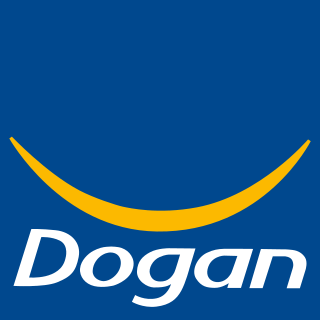
Salmo is a genus of ray-finned fish from the subfamily Salmoninae of family Salmonidae, and is part of the tribe Salmonini along with the sister genera Salvelinus and Salvethymus. Almost all Salmo species are native only in the Old World, the only exception being the Atlantic salmon, which is also naturally found across the North Atlantic in eastern North America.

Stemonitis is a distinctive genus of slime moulds found throughout the world. They are characterised by the tall brown sporangia, supported on slender stalks, which grow in clusters on rotting wood. The genus was first described by German botanist Johann Gottlieb Gleditsch in 1753. A 2014 estimate suggests that there are 18 species in the genus. Identification within the genus is difficult, and can only be performed with confidence using a microscope or by DNA sequencing. A fossil specimen is known from the mid-Cretaceous.

Star TV is a Turkish nationwide TV channel. It has been owned by Ferit Şahenk's Doğuş Media Group since 2011.

Aydın Doğan is a Turkish business magnate and investor. He is the founder of Doğan Holding, one of Turkey's largest conglomerates.

Hürriyet is a major Turkish newspaper, founded in 1948. As of January 2018, it had the highest circulation of any newspaper in Turkey at around 319,000. Hürriyet combines entertainment with news coverage. Since 2018, Hürriyet has shifted from a mainstream, liberal, outlook to a pro-government, right wing, position.
Ziyaettin Dogan is a UEFA Pro Licensed Turkish football manager.

Alburnoides is a genus of cyprinid fishes native to Europe and Asia. Many species are known as riffle minnows or spirlins.
Squalius is a genus of fish in the family Cyprinidae found in Europe and Asia. Hybridization is not rare in the Cyprinidae, including this genus. S. alburnoides is known to be of ancient hybrid origin, with the paternal lineage deriving from a prehistoric species related to Anaecypris; the latter mated with ancestral S. pyrenaicus. Present-day S. alburnoides mates with sympatric congeners of other species.

Apera is a small genus of annual grasses, known commonly as silkybent grass or windgrass. They are native to Europe, North Africa and parts of Asia but have been introduced and naturalized in much of North and South America.

Rostraria is a genus of plants in the grass family, native primarily to Eurasia and North Africa with one species native to South America. Hairgrass is a common name.

Doğan Holding is amongst the biggest conglomerates in Turkey operating in the energy, media, industry, trade, insurance and tourism industries. Founded by Aydın Doğan who still is a major shareholder, the company is led by his daughter Begümhan Doğan Faralyalı. Main operating activity of the Holding is to invest in various sectors via associates, to provide all necessary support to its subsidiaries and joint ventures in order to develop their activities.
Doğan Media Group was a Turkish media conglomerate, part of the Doğan Holding conglomerate. The company was established in 1997 to bring together Doğan's media properties. These include the Posta, Hürriyet, and Radikal newspapers, the television channels Kanal D and CNN Türk, and the Doğan News Agency. It also operated Doğan Kitap, a major book publisher, and Doğan Music Company, a major music label. Doğan also operated print facilities and media distribution, for other newspapers and magazines as well as its own.

Ventenata is a genus of plants in the grass family, native to Europe, North Africa, and central + southwest Asia. One species, Ventenata dubia, is considered an invasive weed in many places.

Balsamia is a genus of truffle-like ascomycete fungi of the family Helvellaceae. The widespread genus contains twenty five species known from Europe, North America, North Africa and Asia, including China.
Barssia is a genus of ascomycete fungi of the family Helvellaceae. The widespread genus contains two species.

Balsamia oregonensis is a species of ascomycete fungus in the family Helvellaceae. It is the type species of the genus Barssia, and is commonly found in Oregon, which it is named for.
Barssia yezomontana is a species of fungus from the genus Barssia. First described by Kobayasi in 1938.
Balsamia luyashanensis is a species of fungus from the genus Balsamia. It was previously placed in the genus Barssia.
Barssia peyronelii is a species of fungus from the genus Barssia.
Balsamia hellenica is a species of fungus from the genus Balsamia. It was previous placed in genus Barssia.











